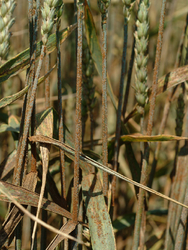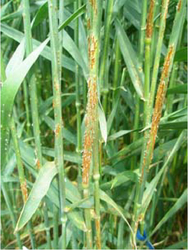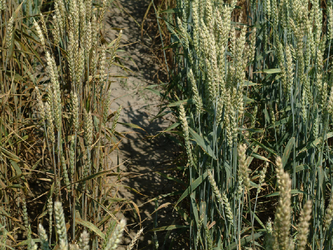Stem rust
Puccinia graminis
Biology
On cereals, black rust forms summer spores (uredospores) and winter spores (teleutospores). In spring, the winter spores germinate and form basidiospores. These spores reach the intermediate host, barberry, by wind dispersal. On the intermediate host, spore deposits are formed (spermogonia on the upper leaf surfaces and azidiospores on the lower leaf surfaces), in which a new type of spore (azidiospores) is formed. In humid weather, the azidiospores are ejected from their stores and carried by the wind. If they reach cereals, they germinate there in the presence of dripping liquid water in a temperature range between 5 and 18 °C and eventually penetrate the plants through the stomata. The rust-colored camps of summer spores (uredospore camps) then form on culms and leaf sheaths and multiply rapidly, spreading the disease through the crop. When the grain matures, the winter spores form in the same or separate spore stores, with which the fungus overwinters on infested crop residues. Under favorable conditions, the rust fungus may also overwinter with the summer spores. In this case, the intermediate host is eliminated. Summer spores can also be spread over long distances by wind and, under favorable conditions, directly infect the grain. Favorable conditions for infection of the grain are days with a leaf wetting period of more than eight hours and a temperature higher than 15°C.
Damage symptoms
Rust-colored spore deposits (uredospores) are formed on culms and leaf sheaths, often arranged in strips. They eventually pierce the epidermis and the remnants of the ruptured epidermis surround the spore deposits. The rust pustules can reach a length of up to 1 cm. When the grain reaches a certain stage of maturity, the black teleutospores (hence the name black rust), which protrude from the leaf tissue in a cushion shape, are formed in the uredospore stores or else in their own spore stores. These rust pustules are also surrounded by the remains of the epidermis. Due to the high temperature requirements and host alternation in the development cycle of the fungus, black rust occurs relatively late in the season, around June. The summer cereals are particularly affected.



Host plants
Black rust is divided into three subspecies (formae speciales, or f. sp. for short) that are adapted to different plant species. Within each forma specialis, black rust forms a number of physiological races that attack different cultivars.
Puccinia graminis f. sp. tritici occurs on wheat, the genera of barley(Hordeum), common whale(Aegilops), oats(Avena), and couch grass(Elymus).
Puccinia graminis f. sp. secalis occurs on rye and barley, and on the grass genera tanglegrasses(Dactylis), couch grass(Elymus), and some other grasses.
Puccinia graminis f. sp. avenae occurs on oats as well as on flying oats and other grass species. The intermediate host for all f. sp. is barberry(Berberis vulgaris), on which certain spore deposits (aecidia and spermogonia) are formed.
Prevention and control
- Cultivation of resistant or less susceptible varieties.
- Carefully incorporate infested crop residues into the soil
- Carefully remove grass from field margins
- Do not plant barberry when planting new windbreaks
- Possibly use plant protection products (see list of plant protection products approved in Austria)
Specialized information
A current classification of the susceptibility of wheat varieties to black rust can be found on the BAES homepage.
Last updated: 02.10.2025
automatically translated